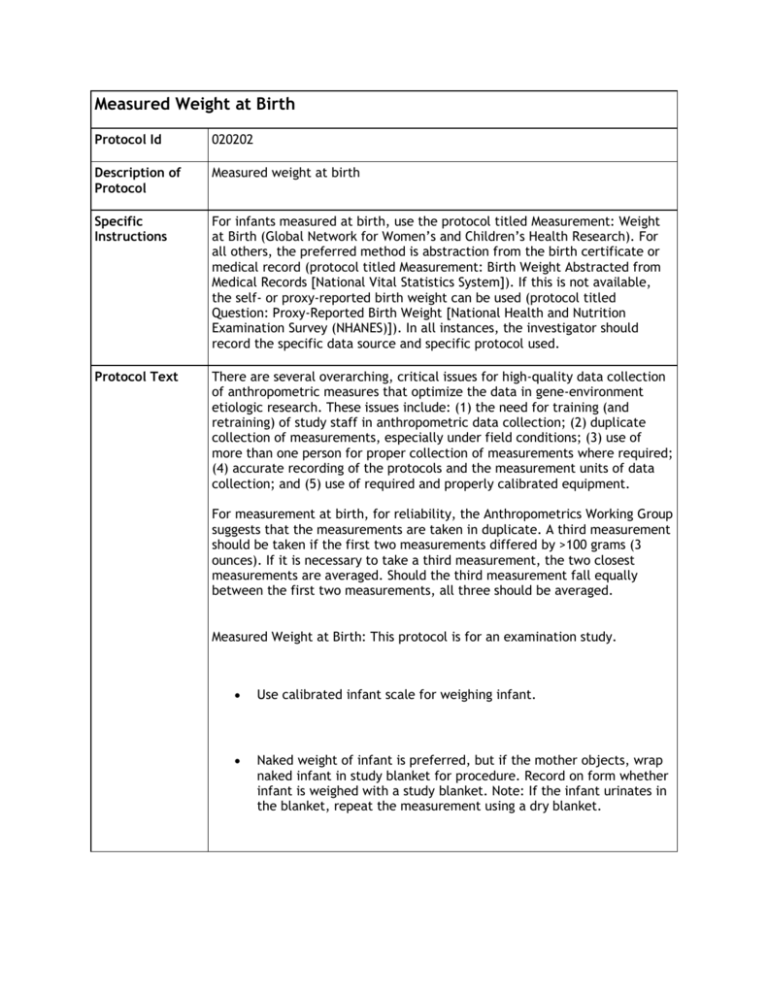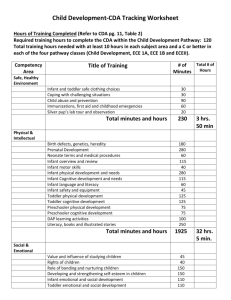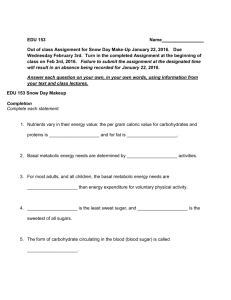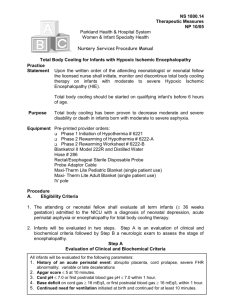Measured Weight at Birth
advertisement

Measured Weight at Birth Protocol Id 020202 Description of Protocol Measured weight at birth Specific Instructions For infants measured at birth, use the protocol titled Measurement: Weight at Birth (Global Network for Women’s and Children’s Health Research). For all others, the preferred method is abstraction from the birth certificate or medical record (protocol titled Measurement: Birth Weight Abstracted from Medical Records [National Vital Statistics System]). If this is not available, the self- or proxy-reported birth weight can be used (protocol titled Question: Proxy-Reported Birth Weight [National Health and Nutrition Examination Survey (NHANES)]). In all instances, the investigator should record the specific data source and specific protocol used. Protocol Text There are several overarching, critical issues for high-quality data collection of anthropometric measures that optimize the data in gene-environment etiologic research. These issues include: (1) the need for training (and retraining) of study staff in anthropometric data collection; (2) duplicate collection of measurements, especially under field conditions; (3) use of more than one person for proper collection of measurements where required; (4) accurate recording of the protocols and the measurement units of data collection; and (5) use of required and properly calibrated equipment. For measurement at birth, for reliability, the Anthropometrics Working Group suggests that the measurements are taken in duplicate. A third measurement should be taken if the first two measurements differed by >100 grams (3 ounces). If it is necessary to take a third measurement, the two closest measurements are averaged. Should the third measurement fall equally between the first two measurements, all three should be averaged. Measured Weight at Birth: This protocol is for an examination study. Use calibrated infant scale for weighing infant. Naked weight of infant is preferred, but if the mother objects, wrap naked infant in study blanket for procedure. Record on form whether infant is weighed with a study blanket. Note: If the infant urinates in the blanket, repeat the measurement using a dry blanket. Selection Rationale Place the infant on the scale so that weight is distributed equally about the center of the pan. Record the weight on form. Remove the infant from the scale, then replace and weigh a second time. Record the second weight on form. If the difference in the two weights is greater than 100 grams, obtain a third measurement. Note the weight of the blanket and subtract the weight of the blanket from the total weight of the infant plus blanket to estimate birth weight of the infant. These protocols utilize methods that would be encountered in most research settings. These protocols encompass different periods of time when the measurement could be collected. The studies from which these protocols are derived also provide valid national comparison data. Ascertainment of birth weight is a high priority when feasible to obtain given the significant relationships that have been shown between birth weight and the risk of selected, important cardiovascular-renal diseases. Source Global Network for Women’s and Children’s Health Research Complementary Feeding, A Global Network Cluster Randomized Controlled Trial Manual of Operations (not available online) Language English Participant All ages Personnel and Training Required Personnel who are trained in the handling of newborns and in the use of calibrated scales. Equipment Needs Digital scale (or beam balance) Standards Standard Name Common Data Elements (CDE) Person Measured Birth 2793342 CDE Browser Weight Value Logical Observation Identifiers Names and Codes (LOINC) Birth Weight Measured General References None Protocol Type Physical Measurement ID 8339-4 Source LOINC Derived Variables Ponderal Index (PI, neonates and infants), Weight-for-Length (W/L, birth to 36 months), Body Mass Index (BMI, 2 years to adults, but some references from birth) Requirements Requirement Category Required Average time of greater than 15 minutes in an unaffected individual No Average time of greater than 15 minutes in an unaffected individual Major equipment No This measure requires a specialized measurement device that may not be readily available in every setting where genome wide association studies are being conducted. Examples of specialized equipment are DEXA, Echocardiography, and Spirometry Specialized requirements for biospecimen collection No This protocol requires that blood, urine, etc. be collected from the study participants. Specialized training This measure requires staff training in the protocol methodology and/or in the conduct of the data analysis. No






![Paediatric Learning outcomes and assessm[...]](http://s3.studylib.net/store/data/006922315_1-5db21f5799804c0c886d177378b8b04c-300x300.png)